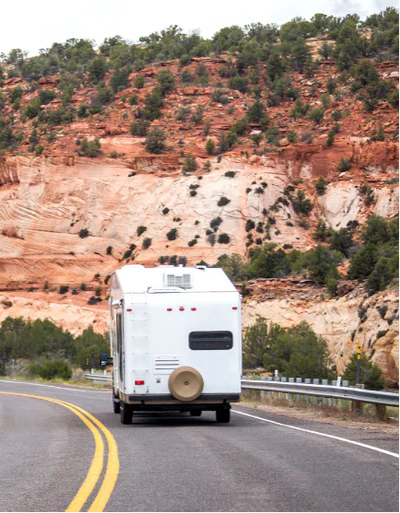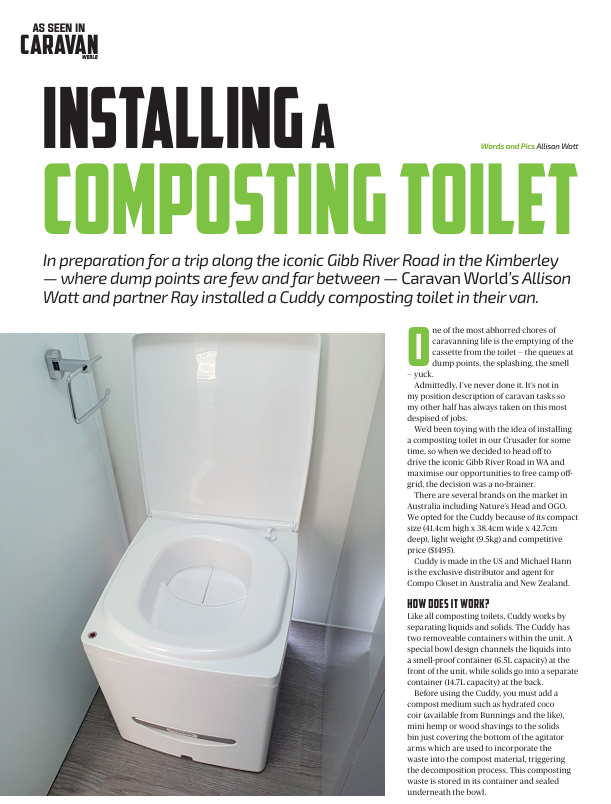Why Choose a Sealing or Composting Toilet for Your RV?
- No Black Tank Needed
- No Water Wasted
- No Chemicals
- Odor-Free
- Space-Saving
- No more dump points!
What are Composting Toilets for RVs?
A composting toilet is a waterless, eco-friendly alternative to traditional RV toilets. They separate and break down human waste using natural processes - no plumbing required.
They eliminate the need for traditional black tanks and sewage hookups, providing more freedom in choosing camping spots or staying off grid longer.
A sealing, or dry flush toilet, is a type of toilet that operates without water, chemicals or extra organic additives. Some models use a compressed air system to power the sealing mechanism, which immediately encapsulates and isolates waste after use.
With a separating sealing toilet, you only have to “seal” solids, reducing bag use for only #2’s!
Compost toilets for RVs separate liquid (urine) and solid waste (poo). The solids go into a storage chamber with organic matter, such as coco coir, to help start the composting process, and the liquids go into a container with a liquid capacity of a gallon or more. Separating liquids from solid matter is the key to ensuring your composting toilet does not smell.
If your toilet has an agitator like the Cuddy composting toilet, you rotate the agitator after each use to mix the solids with the organic matter to start the decomposition process. This helps break down the solids so your solids bin doesn't fill up as quickly.
If you use a portable composting toilet like the Cuddy Lite, you add a handful or so of compost medium to the bin after each "deposit." You will have to empty your waste bin more often, but the overall process remains the same, and you still won't have any odor!
Emptying your rv composting toilet is a breeze and only requires a double-check on local disposal regulations.
It’s pretty simple: you “go” like any other toilet. After each use, you push a button that activates a sealing mechanism so waste gets contained hygienically, and disposed of much like a diaper (but sealed so no smell!).
With a separating feature, urine gets diverted into a different container and is emptied as needed.
As popular as composting toilets for RVs are right now, there are some pros and cons to be aware of. You might prefer a sealing toilet for your RV, but here are pros and cons to both for you to consider:

We might be biased, but we think sealing and composting toilets are pretty darn cool. Here are some of the best facts that we get excited about!
As with all great things, composting and sealing toilets come with a small learning curve. Most users quickly adapt, especially by following a few simple tips, you should be able to keep your toilet happy and in tip-top shape

Think it’s difficult to convert your RV toilet? Think again! Here’s a free DIY guide for installing a composting toilet in an RV.
Originally published by CaravanWorld.AU and can be viewed online.
Due to how composting toilets work, you should only notice an earthy smell, much like the dirt outside in a very humid environment. If you do notice any odor that resembles poo, you probably just need to add some more organic matter to your solids bin, or it might be time to empty it completely.
Compost toilets for RVs separate liquid (urine) and solid waste (poo). The solids go into a storage chamber with organic matter, such as coco coir, to help start the composting process, and the liquids go into a container with a liquid capacity of a gallon or more. Separating liquids from solid matter is the key to ensuring your composting toilet does not smell.
If your toilet has an agitator like the Cuddy, you rotate the agitator after each use to mix the solids with the organic matter to start the decomposition process. This helps break down the solids so your solids bin doesn't fill up as quickly.
If you use a composting toilet like the Cuddy Lite, which doesn't have an agitator, you typically add a little bit of organic matter to the bin after each "deposit." You will have to empty your waste bin more often, but the overall process remains the same, and you still won't have any odor!
When your solids bin is ready to be emptied, you simply put it in a biodegradable bag and dispose of it in an approved waste eceptacle.
Typically, you can follow the same guidelines as disposing of baby diapers. Just remember that your solid waste is not yet fully composted, so it's technically still disposing of human waste.
In short, yes! Although it might be more difficult in some RV setups.
If your RV has a built-in cassette toilet, removal might be challenging. Since Cuddy is so small, some people opt to leave the hardware to their current system and simply put Cuddy into their bathroom space. Cuddy also fits right into the space that was designed for your portable chemical toilet, making it an easy replacement process.
Emptying your RV compost toilet is super easy! If you have a Cuddy Composting Toilet you will simply open the unit and remove the removable solids bin, grab your bag and use the handy handles to empty the contents into the bag.
With a Cuddy Lite you will open and remove the bag and put in a new bag for continued use - zip zap easy as that.
Check out this article on for more information on emptying an RV composting toilet:
This will depend on the solid capacity and liquid capacity of your ideal composting toilet. With Cuddy, you will empty your solids bin every 2-4 weeks and your liquids container every 1-2 days. Again, this is depending on how many people are using Cuddy.
The best thing to do before you travel or before you hit a new state is to check with the local authority. Each will have very specific rules for composting toilets, and where and how you dump your grey water and solids load will matter.
No, BUT we recommend wiring in the small fan for Cuddy to help with moisture control and the decomposition process. Cuddy can easily be unplugged from the power source when you empty and clean it or if you want to put it outside to use while camped for extended periods.
The cost to install a composting toilet in your RV can vary greatly, but with Cuddy, there could be no cost! If you already have a space for Cuddy, the only additional cost might be some wire connectors to connect the fan to your battery system. Some composting toilets require mounting and external venting, but Cuddy is ready to "go"!
The best composting toilets will align with your needs, including cost, ease of installation, and capacity. Cuddy checks all the boxes as the smallest composting toilet on the market with an agitator and a generous solids and liquids capacity. Installation is a breeze, with no need to drill external holes in your RV for venting.
After many collective years of the Compo Crew using them ourselves, we truly believe that compost toilets for RVs, van life, and even a tiny house is the best choice for your poo.
Composting toilets are eco-friendly and sustainable, reduce the use of fresh water, are easy to empty and clean, and are great for the entire family to use. You don't have to worry about emptying a black water tank, and you can remain self-contained anywhere you travel.
And if we do say so ourselves, Cuddy is pretty darn cute!
Yes! With our S1 Dry Flush Adapter Kit
Still have questions? We love talking toilets! Contact us and we’ll get back to you ASAP.